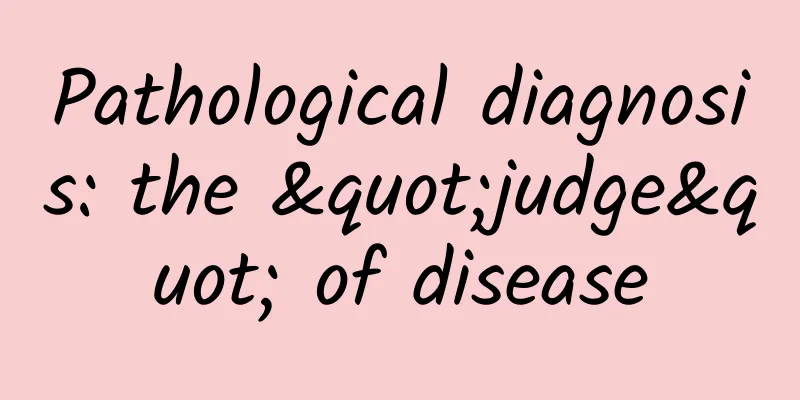Pathological diagnosis: the "judge" of disease

|
Author: Du Xiaomin Jilin Provincial People's Hospital Reviewer: Zhang Weili, deputy chief physician, Jilin Provincial People's Hospital In the vast universe of medicine, pathological diagnosis is like a shining star, leading us to explore the nature of diseases with its unique charm. Today, let us embark on the journey of pathological diagnosis together, unveil the mystery of this field, and understand how it has become an indispensable part of modern medicine. 1. Pathological diagnosis: the "judge" of the disease Pathological diagnosis, in short, is the process of making a final judgment on the disease by observing and analyzing specimens such as human tissues, cells and body fluids, combined with clinical information. It is known as the "gold standard" for disease diagnosis because pathological examination directly faces the essence of the lesion and is the key to determining the nature, type, stage and prognosis of the disease. In medical practice, the clinical manifestations of many diseases are complex and changeable, and it is often difficult to make a clear diagnosis based on clinical symptoms, signs and imaging examinations alone. Pathological diagnosis can go deep into the microscopic level of the disease and discover abnormal changes in the diseased tissue through careful observation under a microscope, thus providing clinicians with accurate treatment basis. 2. Pathological diagnosis process: from specimen to conclusion The process of pathological diagnosis is not achieved overnight; it involves multiple links, and each step is crucial. Specimen collection: This is the first step in pathological diagnosis, which requires clinicians to accurately obtain pathological tissue specimens through surgery, puncture, etc. The quality of the specimen directly affects the subsequent diagnostic results. Specimen processing: The collected specimens will go through a series of processing, including fixation, dehydration, embedding, sectioning and staining. These steps are designed to maintain the integrity of the specimen while making its internal structure clearly visible for easy observation. Microscopic observation: The processed specimens will be placed under a microscope and carefully observed by a professional pathologist. The pathologist will identify diseased cells based on morphological changes in the cells, such as nuclear atypia and disordered cell arrangement. Figure 1 Copyright image, no permission to reprint Comprehensive diagnosis: Based on microscopic observation, the pathologist will give a pathological diagnosis. The clinician will conduct a comprehensive analysis and judgment based on the patient's clinical information, imaging data, laboratory test results and pathological diagnosis, and finally reach a diagnosis conclusion. This process requires a high degree of professionalism and rich clinical experience. 3. The significance of pathological diagnosis: the cornerstone of precision medicine Pathological diagnosis plays an irreplaceable role in modern medicine. It is the cornerstone of precision medicine. Precision medicine emphasizes the development of individualized treatment plans based on individual differences of patients. Pathological diagnosis provides a scientific basis for precision medicine by revealing the nature of the disease. Guiding treatment: Pathological diagnosis can clarify the nature, type and stage of the disease, and provide an important basis for clinicians to formulate treatment plans. For example, in tumor treatment, pathological diagnosis can determine the malignancy of the tumor, the scope of infiltration and lymph node metastasis, thereby helping doctors choose appropriate surgical methods, chemotherapy regimens and radiotherapy doses. Figure 2 Copyright image, no permission to reprint Prognosis assessment: Pathological diagnosis can also predict the outcome and prognosis of the disease by evaluating the biological behavior of the diseased tissue. This is very important for patients because it can help them better understand their condition and develop a reasonable rehabilitation plan. Promote scientific research: The large amount of data and information accumulated in the process of pathological diagnosis provides valuable materials for medical research. Through the analysis and research of these data, we can reveal the pathogenesis of the disease, explore new treatment methods, and promote the progress of medical science. 4. Challenges and future of pathological diagnosis Although pathological diagnosis plays an important role in modern medicine, it also faces many challenges. With the rapid development of medical technology, pathological diagnosis also needs to be continuously innovated and improved. Technological innovation: The application of new technologies such as digital pathology and artificial intelligence has brought revolutionary changes to pathological diagnosis. Digital pathology converts pathological sections into digital images through scanning technology, realizing remote consultation and resource sharing; while artificial intelligence can assist pathologists in making rapid diagnoses through deep learning algorithms. Talent cultivation: Pathological diagnosis requires pathologists to have high professional qualities and rich clinical experience, so talent cultivation is particularly important. In the future, we need to strengthen the construction and development of pathology disciplines, cultivate more outstanding pathologists and researchers, and inject new vitality into the cause of pathological diagnosis. Interdisciplinary cooperation: Pathology needs to work closely with multiple disciplines such as clinical, imaging, and testing. Through interdisciplinary cooperation and communication, we can have a more comprehensive understanding of the nature and characteristics of the disease and provide patients with more accurate and personalized treatment plans. In short, with the in-depth exploration of pathological diagnosis, more and more diseases will be exposed. Let us work together to promote the prosperity and development of pathological diagnosis in this era full of challenges and opportunities! |
<<: A cure for constipation opens the door to convenience for the elderly
Recommend
Can I use a fan during pregnancy?
Pregnancy is a special period, and there are usua...
How long after having an abortion can I wear a ring?
Wearing an IUD can have a long-term contraceptive...
“Aseptic eggs” ≠ sterile! Do you still dare to “eat them raw”?
Audit expert: Wang Guoyi Postdoctoral fellow in N...
Can I wash my hair during the confinement period?
The short period of confinement is also called mi...
What is the normal progesterone level at 8 weeks?
Different changes will occur in the body at diffe...
What does a positive urine test mean for women?
Usually, when people get sick and go to the hospi...
How to improve your physical fitness before pregnancy?
Although the second-child policy has been opened ...
What's the problem with nipple pain recently?
To say that life is really not easy for women is ...
What are the dangers of soldering for girls?
Solder is not only harmful to girls but also to e...
Can I have a blood test during my period?
Many ladies have checkups during their menstrual ...
Illustration | National Occupational Disease Prevention and Control Plan (2021-2025)
Source: National Health Commission official websi...
Counterpoint: Global high-end smartphone market to grow 8% in 2024
According to Counterpoint's tracking report, ...
What medicine should I take for uterine inflammation?
When it comes to uterine inflammation, the first ...
Why do women have excessive yin deficiency and fire?
Yin deficiency and hyperactivity of fire is the n...
What does low body temperature after ovulation mean?
After ovulation, a woman's body will show cer...









